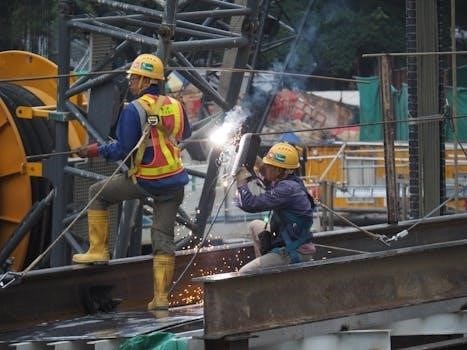What is a Welding Procedure Specification (WPS)?
A Welding Procedure Specification (WPS) is a formal document providing welders with detailed instructions. It outlines parameters for consistent, quality welds. The WPS includes crucial details regarding joint design, materials, techniques, and welding parameters, ensuring standardized execution.
Definition and Purpose of a WPS
A Welding Procedure Specification (WPS) is a meticulously crafted document that provides a detailed roadmap for welders. It serves as a comprehensive guide, specifying the exact welding parameters, techniques, and materials necessary to achieve a desired weld quality. The primary purpose of a WPS is to ensure consistency and repeatability in welding operations. By outlining crucial variables like joint design, base metals, filler metals, welding positions, preheat, and post-weld heat treatment, it minimizes variations in weld quality. This standardization is paramount for producing welds that meet the required mechanical properties and application standards. The WPS acts as a control mechanism, helping maintain high quality and reduce the risk of errors or defects. It also provides a reference point for inspections, audits, and troubleshooting, thus playing a pivotal role in ensuring structural integrity and safety in welded constructions. Ultimately, a WPS aims to produce consistent and reliable welds.
Why a WPS is Important for Welding
A Welding Procedure Specification (WPS) is crucial for maintaining weld quality, consistency, and structural integrity. It guides welders to follow standardized procedures, minimizing errors and ensuring welds meet specified requirements. Without a WPS, variations in welding parameters can lead to inconsistent and potentially unsafe welds. The WPS helps in optimizing productivity by reducing rework and minimizing defects. It also provides a clear framework for training welders and helps in achieving compliance with industry standards and codes. Moreover, a WPS can be a customer request or a regulatory requirement, making it an essential part of quality control. The WPS allows for accurate documentation, aiding in traceability and troubleshooting. Using a WPS reduces the risk of company liability by ensuring that welding is carried out in a safe and standardized manner. The adoption of a WPS is a cornerstone of effective and reliable welding practices.

Key Components of a WPS
A WPS contains essential, non-essential, and supplementary essential variables. These variables dictate the welding process, materials, and techniques. Understanding these components ensures the correct application of a WPS for quality welds.
Essential Variables in a WPS
Essential variables in a WPS are parameters that, if changed, necessitate requalification of the welding procedure. These critical factors significantly impact the mechanical properties and integrity of the weld. They include the welding process itself, such as SMAW, GMAW, or GTAW, and the type of base metal being joined, including its specification and thickness. Changes in filler metal classification, including the specific type and diameter, are also considered essential. The welding position, whether it’s flat, horizontal, vertical, or overhead, is a key element. Heat input parameters, including amperage, voltage, and travel speed, must be carefully controlled. Any variation in these parameters can affect the weld’s strength, ductility, and overall quality, requiring a new qualification test to ensure the integrity of the weld.
Non-Essential Variables in a WPS
Non-essential variables in a WPS are those parameters that can be altered within specified limits without requiring a complete requalification of the welding procedure. These variables typically involve aspects that do not significantly affect the mechanical properties of the weld. Examples include the technique of welding, such as stringer or weave beads, and minor adjustments to the travel speed within a defined range. The specific current type (AC or DC) and polarity can be non-essential if their change does not impact the weld’s integrity. Also, variations in the shielding gas flow rate within acceptable limits can be considered non-essential. While changes to these parameters might be made, it is good practice to document any adjustments made to maintain a record of the welding process. These variables offer flexibility within the welding parameters.
Supplementary Essential Variables in a WPS
Supplementary essential variables in a WPS are specific parameters that, when altered, might necessitate requalification depending on the governing code or standard. These variables are often related to the toughness requirements or specific service conditions of the welded joint. Changes such as switching from one filler metal classification to another, or altering the welding position, could be considered supplementary essential variables. Additionally, modifications to the preheat or interpass temperature ranges can also fall into this category. For instance, if a preheat temperature is significantly increased or decreased, it may require requalification. Other changes like the heat input range or the specific welding technique, if critical to the application, can be supplementary essential variables. Unlike essential variables, the need for requalification depends on the specific application and code requirements.

Types of WPS and Their Applications
Welding Procedure Specifications (WPS) come in different types, such as Standard WPS (SWPS) and Prequalified WPS. Each type serves specific purposes and has unique applications. These variations cater to diverse welding needs and standards.
Standard Welding Procedure Specification (SWPS)
A Standard Welding Procedure Specification, often abbreviated as SWPS, is a pre-developed welding procedure provided by organizations like the American Welding Society (AWS). These SWPS documents are designed to be used for common welding applications, offering a readily available and standardized approach. Typically, SWPS documents cover specific welding processes, materials, and joint configurations. They are created based on extensive testing and research, ensuring that the parameters used will produce welds of acceptable quality. SWPS documents simplify the process for companies and welders by eliminating the need to develop a WPS from scratch for routine welding tasks. However, it is critical to confirm that the SWPS is applicable to the specific job requirements, including base metal compatibility and joint design. SWPS documents can significantly reduce costs and time associated with qualifying a unique WPS. They are a valuable resource for companies seeking to ensure consistent and quality welding operations using standardized procedures.
Prequalified WPS
A prequalified Welding Procedure Specification (WPS) is a welding procedure that does not require testing or qualification before use. These procedures are developed based on established welding codes and standards, such as those from the American Welding Society (AWS), and they are considered pre-approved if specific criteria are met. A prequalified WPS typically outlines parameters for common welding processes, materials, and joint types, assuming adherence to all stipulated requirements. These requirements often include specific material thicknesses, welding positions, filler metals, and joint designs. The advantage of utilizing a prequalified WPS is the significant reduction in time and costs associated with procedure qualification. However, it’s crucial to meticulously ensure that the proposed application aligns perfectly with the limitations and requirements outlined in the relevant prequalification standard. Any deviations may necessitate the development and qualification of a new, non-prequalified WPS through testing. Using a prequalified WPS can streamline the welding process when applicable, ensuring quality welds without additional testing.

Creating and Implementing a WPS
Creating and implementing a Welding Procedure Specification (WPS) involves developing a detailed document. This document is used to guide welders, ensuring consistent, quality welds. It requires understanding welding variables and proper documentation.
The Role of the Welding Procedure Qualification Record (WPQR)
The Welding Procedure Qualification Record (WPQR) is a crucial document that underpins the development of a Welding Procedure Specification (WPS). The WPQR serves as evidence that a specific welding procedure, when followed, produces a weld with the required mechanical properties and integrity. It’s essentially a record of a successful weld test. This qualification process involves creating test pieces using the intended welding parameters and then subjecting them to various tests, such as non-destructive testing (NDT), to confirm the weld’s quality. The WPQR documents the results of these tests, providing a verifiable basis for the WPS. A WPQR is needed to validate the welding parameters. This evidence allows the WPS to be used with confidence, knowing the welding procedure will produce acceptable results. The WPQR ensures that the welding procedure is feasible and reliable, forming the foundation for standardized welding practices. Without a valid WPQR, a WPS lacks the necessary validation.
Developing In-House WPS from WPQRs
Developing in-house Welding Procedure Specifications (WPS) from Welding Procedure Qualification Records (WPQRs) is a critical step for any welding operation aiming for consistency and quality. The WPQR provides the verified parameters from successful weld tests, which then serve as the foundation for creating a practical WPS. This process involves carefully analyzing the WPQR to identify essential variables, like welding process, base material, filler metal, current, voltage, travel speed, and preheat temperature. These variables are then translated into a clear and concise WPS document that can be easily followed by welders. The in-house WPS should include all relevant information from the WPQR, tailored for specific applications. This includes detailed instructions on joint preparation, welding techniques, and any specific requirements. By basing the WPS on a valid WPQR, organizations ensure that their welding practices are supported by proven results, leading to reliable and repeatable weld quality. Creating in-house WPS allows for tailored procedures.

WPS in Practice
In practice, a WPS guides welders with specific parameters, ensuring consistent welds. It includes details like joint type, material, and welding process. Proper implementation of a WPS leads to repeatable, quality welds.
Sample WPS Form and Its Elements
A sample Welding Procedure Specification (WPS) form typically includes several key elements to provide comprehensive welding guidance. The form starts with basic information such as the company name, WPS number, revision number, and dates of authorization. It also references the supporting Procedure Qualification Records (PQR). Essential details include the welding process, like SMAW, GMAW, or FCAW, and specific joint details such as type, root opening, and backing. The technique, whether stringer or weave, is specified along with electrical characteristics like current type and transfer mode. The form also documents filler metal specifications, including AWS classifications, and welding parameters such as current, voltage, and travel speed. Furthermore, it will indicate preheat and interpass temperature requirements, as well as any post-weld heat treatment details. A well-structured WPS form ensures that all essential variables are clearly defined, allowing welders to consistently produce welds that meet the required quality standards. This form serves as the main reference document for welding operations.
Ensuring Consistent Welding with a WPS
A Welding Procedure Specification (WPS) is crucial for ensuring consistent welding because it standardizes the welding process. By meticulously detailing all welding parameters, it minimizes variability and promotes repeatable results. Welders adhere to the WPS, which outlines joint configurations, base and filler materials, welding techniques, and electrical settings. This adherence ensures that each weld is performed under the same conditions, reducing human error and deviations. The WPS also specifies essential variables, such as preheat and interpass temperatures, that directly impact weld quality. Moreover, using a WPS enables easier inspection and testing, leading to better quality control. Following a WPS reduces the risk of company liability by ensuring that welding complies with specified safety standards. Ultimately, a WPS fosters consistency across all welding operations, resulting in structurally sound and reliable welds, thereby increasing productivity and decreasing rework.





